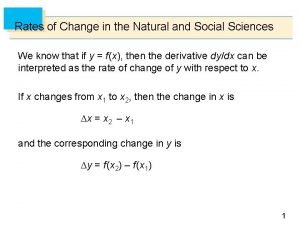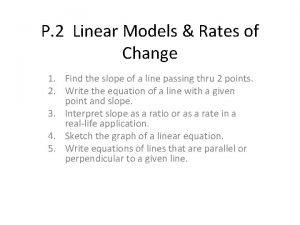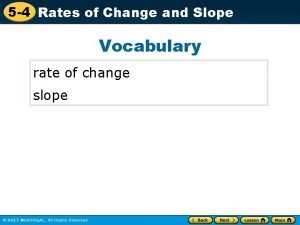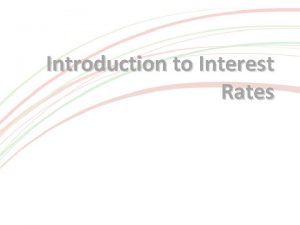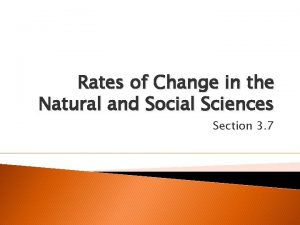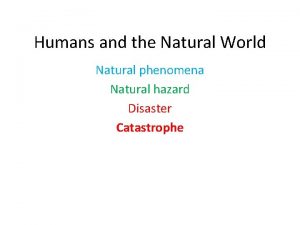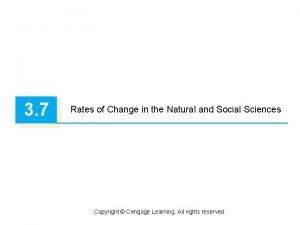Rates of Change in the Natural and Social










































- Slides: 42

Rates of Change in the Natural and Social Sciences We know that if y = f (x), then the derivative dy/dx can be interpreted as the rate of change of y with respect to x. If x changes from x 1 to x 2, then the change in x is x = x 2 – x 1 and the corresponding change in y is y = f (x 2) – f (x 1) 1

Rates of Change in the Natural and Social Sciences The average rate of change of y with respect to x can be interpreted as the slope of the secant line PQ Figure 1 m. PQ = average rate of change m = f (x 1) = instantaneous rate of change 2

Rates of Change in the Natural and Social Sciences Its limit as x 0 is the derivative f (x 1), which can be interpreted as the instantaneous rate of change of y with respect to x or the slope of the tangent line at P(x 1, f (x 1)). 3

Physics If s = f (t) is the position function of a particle that is moving in a straight line, then: s/ t represents the average velocity over a time period t, and v = ds/dt represents the instantaneous velocity (the rate of change of displacement with respect to time). The instantaneous rate of change of velocity with respect to time is acceleration: a(t) = v (t) = s (t). 4

Example 1 The position of a particle is given by the equation s = f (t) = t 3 – 6 t 2 + 9 t where t is measured in seconds and s in meters. (a) Find the velocity at time t. (b) What is the velocity after 2 s? After 4 s? (c) When is the particle at rest? (d) When is the particle moving forward (that is, in the positive direction)? (e) Draw a diagram to represent the motion of the particle. (f) Find the total distance traveled by the particle during the first five seconds. (g) Find the acceleration at time t and after 4 s. 5

Example 1 (h) Graph the position, velocity, and acceleration functions for 0 t 5. (i) When is the particle speeding up? When is it slowing down? Solution: (a) Find the velocity at time t. The velocity function is the derivative of the position function. s = f (t) = t 3 – 6 t 2 + 9 t v (t) = = 3 t 2 – 12 t + 9 6

Example 1 – Solution cont’d (b) What is the velocity after 2 s? After 4 s? The velocity after 2 s means the instantaneous velocity when t = 2 , that is: v (2) = = 3(2)2 – 12(2) + 9 = – 3 m/s The velocity after 4 s is: v (4) = 3(4)2 – 12(4) + 9 = 9 m/s 7

Example 1 – Solution cont’d (c) The particle is at rest when velocity is 0, v (t) = 0, that is: 3 t 2 – 12 t + 9 = 3(t 2 – 4 t + 3) = 3(t – 1)(t – 3) =0 and this is true when t = 1 or t = 3. Thus the particle is at rest after 1 s and after 3 s. 8

Example 1 – Solution cont’d (d) The particle moves in the positive direction when v (t) >0, that is: 3 t 2 – 12 t + 9 = 3(t – 1)(t – 3) > 0 This inequality is true when both factors are positive (t > 3) or when both factors are negative (t < 1). Thus the particle moves in the positive direction in the time intervals t < 1 and t > 3. It moves backward (in the negative direction) when 1 < t < 3. 9

Example 1 – Solution cont’d (e) Using the information from part (d) we make a schematic sketch in Figure 2 of the motion of the particle back and forth along a line (the s-axis). Figure 2 10

Example 1 – Solution cont’d (f) Find the total distance traveled by the particle during the first five seconds: From parts (d) and (e), we need to calculate the distances traveled during the time intervals [0, 1], [1, 3], and [3, 5] separately. The distance traveled in the first second is | f (1) – f (0) | = | 4 – 0 | =4 m From t = 1 to t = 3 the distance traveled is | f (3) – f (1) | = | 0 – 4 | =4 m From t = 3 to t = 5 the distance traveled is | f (5) – f (3) | = | 20 – 0 | = 20 m The total distance is 4 + 20 = 28 m. 11

Example 1 – Solution cont’d (g) Find the acceleration at time t and after 4 s. The acceleration is the derivative of the velocity function: a(t) = = = 6 t – 12 a(4) = 6(4) – 12 = 12 m/s 2 12

Example 1 – Solution cont’d (h) Graph the position, velocity, and acceleration functions for 0 t 5. Figure 3 shows the graphs of s, v, and a. Figure 3 13

Example 1 – Solution cont’d (i) When is the particle speeding up? When is it slowing down? The particle speeds up when the velocity is positive and increasing (v and a are both positive) and also when the velocity is negative and decreasing (v and a are both negative). In other words, the particle speeds up when the velocity and acceleration have the same sign. (The particle is pushed in the same direction it is moving. ) From Figure 3 we see that this happens when 1 < t < 2 and when t > 3. 14

Example 1 – Solution cont’d The particle slows down when v and a have opposite signs, that is, when 0 t < 1 and when 2 < t < 3. Figure 4 summarizes the motion of the particle. Figure 4 15

Video Example: From: My Secret Math Tutor https: //www. youtube. com/watch? v=Ux. Yw. Lc. Zw. JCs From: Math Gives You Power https: //www. youtube. com/watch? v=Msp. Cz. Wyf. Vw. Y From: Skott Kennedy https: //www. youtube. com/watch? v=9 ot 21 Up_mj 4 16

Example 2 If a rod or piece of wire is homogeneous, then its linear density is uniform and is defined as the mass per unit length ( = m / l ) and measured in kilograms per meter. Suppose, however, that the rod is not homogeneous but that its mass measured from its left end to a point x is m = f (x), as shown in Figure 5 17

Example 2 cont’d The mass of the part of the rod that lies between x = x 1 and x = x 2 is given by m = f (x 2) – f (x 1), so the average density of that part of the rod is If we now let x 0 (that is, x 2 x 1), we are computing the average density over smaller and smaller intervals. The linear density at x 1 is the limit of these average densities as x 0; that is, the linear density is the rate of change of mass with respect to length. 18

Example 2 cont’d Symbolically, Thus the linear density of the rod is the derivative of mass with respect to length. For instance, if m = f (x) = where x is measured in meters and m in kilograms, then the average density of the part of the rod given by 1 x 1. 2 is while the density right at x = 1 is Take Derivative and plug in 1 19

Example 3 A current exists whenever electric charges move. Figure 6 shows part of a wire and electrons moving through a plane surface, shaded red. Figure 6 If Q is the net charge that passes through this surface during a time period t, then the average current during this time interval is defined as 20

Example 3 cont’d If we take the limit of this average current over smaller and smaller time intervals, we get what is called the current I at a given time t 1: Thus the current is the rate at which charge flows through a surface. It is measured in units of charge per unit time (often coulombs per second, called amperes). 21

Homework Web. Assign From Textbook Page 173 #1, 5, 7, 8, 22

Rates of Change in the Natural and Social Sciences Thermodynamics 23

Example 5 One of the quantities of interest in thermodynamics is compressibility. If a given substance is kept at a constant temperature, then its volume V depends on its pressure P. We can consider the rate of change of volume with respect to pressure—namely, the derivative d. V/d. P. As P increases, V decreases, so d. V/d. P < 0. The compressibility is defined by introducing a minus sign and dividing this derivative by the volume V: 24

Example 5 cont’d Thus β measures how fast, per unit volume, the volume of a substance decreases as the pressure on it increases at constant temperature. For instance, the volume V (in cubic meters) of a sample of air at 25 C was found to be related to the pressure P (in kilopascals) by the equation The rate of change of V with respect to P when P = 50 k. Pa is 25

Example 5 cont’d = – 0. 00212 m 3/k. Pa The compressibility at that pressure is = 0. 02 (m 3/k. Pa)/m 3 26

Biology 27

Example 6 Let n = f (t) be the number of individuals in an animal or plant population at time t. The change in the population size between the times t = t 1 and t = t 2 is n = f (t 2) – f (t 1), and so the average rate of growth during the time period t 1 t t 2 is average rate of growth The instantaneous rate of growth is obtained from this average rate of growth by letting the time period t approach 0: growth rate 28

Example 6 cont’d Strictly speaking, this is not quite accurate because the actual graph of a population function n = f (t) would be a step function that is discontinuous whenever a birth or death occurs and therefore not differentiable. However, for a large animal or plant population, we can replace the graph by a smooth approximating curve as in Figure 7 A smooth curve approximating a growth function 29

Example 6 cont’d To be more specific, consider a population of bacteria in a homogeneous nutrient medium. Suppose that by sampling the population at certain intervals it is determined that the population doubles every hour. If the initial population is n 0 and the time t is measured in hours, then f (1) = 2 f (0) = 2 n 0 f (2) = 2 f (1) = 22 n 0 f (3) = 2 f (2) = 23 n 0 and, in general, f (t) = 2 tn 0 30

Example 6 cont’d The population function is n 0 = n 02 t. Note that: So the rate of growth of the bacteria population at time t is This is an example of an exponential function. 31

Economics 32

Example 8 Suppose C(x) is the total cost that a company incurs in producing x units of a certain commodity. The function C is called a cost function. If the number of items produced is increased from x 1 to x 2, then the additional cost is C = C(x 2) – C (x 1), and the average rate of change of the cost is 33

Example 8 cont’d The limit of this quantity as x 0, that is, the instantaneous rate of change of cost with respect to the number of items produced, is called the marginal cost by economists: marginal cost [Since x often takes on only integer values, it may not make literal sense to let x approach 0, but we can always replace C(x) by a smooth approximating function as in Example 6. ] Taking x = 1 and n large (so that x is small compared to n), we have C (n) ≈ C(n + 1) – C(n) 34

Example 8 cont’d Thus the marginal cost of producing n units is approximately equal to the cost of producing one more unit [the (n + 1)st unit]. It is often appropriate to represent a total cost function by a polynomial C(x) = a + bx + cx 2 + dx 3 where a represents the overhead cost (rent, heat, maintenance) and the other terms represent the cost of raw materials, labor, and so on. 35

Example 8 cont’d For instance, suppose a company has estimated that the cost (in dollars) of producing x items is C(x) = 10, 000 + 5 x + 0. 01 x 2 Then the marginal cost function is C (x) = 5 + 0. 02 x The marginal cost at the production level of 500 items is C (500) = 5 + 0. 02(500) = $15/ item 36

Example 8 cont’d This gives the rate at which costs are increasing with respect to the production level when x = 500 and predicts the cost of the 501 st item. The actual cost of producing the 501 st item is C(501) – C(500) = [10, 000 + 5(501) +0. 01(501)2] – [10, 000 + 5(500) +0. 01(500)2] = $15. 01 Notice that C (500) ≈ C(501) – C(500). 37

Other Sciences 38

Other Sciences Rates of change occur in all the sciences. A geologist is interested in knowing the rate at which an intruded body of molten rock cools by conduction of heat into surrounding rocks. An engineer wants to know the rate at which water flows into or out of a reservoir. An urban geographer is interested in the rate of change of the population density in a city as the distance from the city center increases. A meteorologist is concerned with the rate of change of atmospheric pressure with respect to height. 39

A Single Idea, Many Interpretations 40

A Single Idea, Many Interpretations Velocity, density, current, power, and temperature gradient in physics; rate of reaction and compressibility in chemistry; rate of growth and blood velocity gradient in biology; marginal cost and marginal profit in economics; rate of heat flow in geology; rate of improvement of performance in psychology; rate of spread of a rumor in sociology—these are all special cases of a single mathematical concept, the derivative. This is an illustration of the fact that part of the power of mathematics lies in its abstractness. 41

A Single Idea, Many Interpretations A single abstract mathematical concept (such as the derivative) can have different interpretations in each of the sciences. When we develop the properties of the mathematical concept once and for all, we can then turn around apply these results to all of the sciences. This is much more efficient than developing properties of special concepts in each separate science. 42
 Rates of change in the natural and social sciences
Rates of change in the natural and social sciences A rate is a ratio that compares
A rate is a ratio that compares Ratios rates and unit rates guided notes
Ratios rates and unit rates guided notes Ratios rates and unit rates
Ratios rates and unit rates Ratios rates and unit rates
Ratios rates and unit rates Average rate of change
Average rate of change Linear models and rates of change
Linear models and rates of change Variable rate of change
Variable rate of change Social work: an empowering profession 9th edition chapter 1
Social work: an empowering profession 9th edition chapter 1 Natural capital
Natural capital Social thinking social influence social relations
Social thinking social influence social relations Social thinking social influence social relations
Social thinking social influence social relations Flow diagram of the energy system
Flow diagram of the energy system Chemical vs physical change
Chemical vs physical change Absolute change and relative change formula
Absolute change and relative change formula Difference between chemical and physical change
Difference between chemical and physical change Supply and demand curve shifts
Supply and demand curve shifts Physical change
Physical change Rocks change due to temperature and pressure change
Rocks change due to temperature and pressure change Whats the difference between physical and chemical changes
Whats the difference between physical and chemical changes First and second order change
First and second order change Natural hazards vs natural disasters
Natural hazards vs natural disasters Hình ảnh bộ gõ cơ thể búng tay
Hình ảnh bộ gõ cơ thể búng tay Bổ thể
Bổ thể Tỉ lệ cơ thể trẻ em
Tỉ lệ cơ thể trẻ em Gấu đi như thế nào
Gấu đi như thế nào Tư thế worm breton là gì
Tư thế worm breton là gì Hát lên người ơi
Hát lên người ơi Môn thể thao bắt đầu bằng từ đua
Môn thể thao bắt đầu bằng từ đua Thế nào là hệ số cao nhất
Thế nào là hệ số cao nhất Các châu lục và đại dương trên thế giới
Các châu lục và đại dương trên thế giới Công thức tiính động năng
Công thức tiính động năng Trời xanh đây là của chúng ta thể thơ
Trời xanh đây là của chúng ta thể thơ Mật thư anh em như thể tay chân
Mật thư anh em như thể tay chân Phép trừ bù
Phép trừ bù độ dài liên kết
độ dài liên kết Các châu lục và đại dương trên thế giới
Các châu lục và đại dương trên thế giới Thơ thất ngôn tứ tuyệt đường luật
Thơ thất ngôn tứ tuyệt đường luật Quá trình desamine hóa có thể tạo ra
Quá trình desamine hóa có thể tạo ra Một số thể thơ truyền thống
Một số thể thơ truyền thống Bàn tay mà dây bẩn
Bàn tay mà dây bẩn Vẽ hình chiếu vuông góc của vật thể sau
Vẽ hình chiếu vuông góc của vật thể sau
